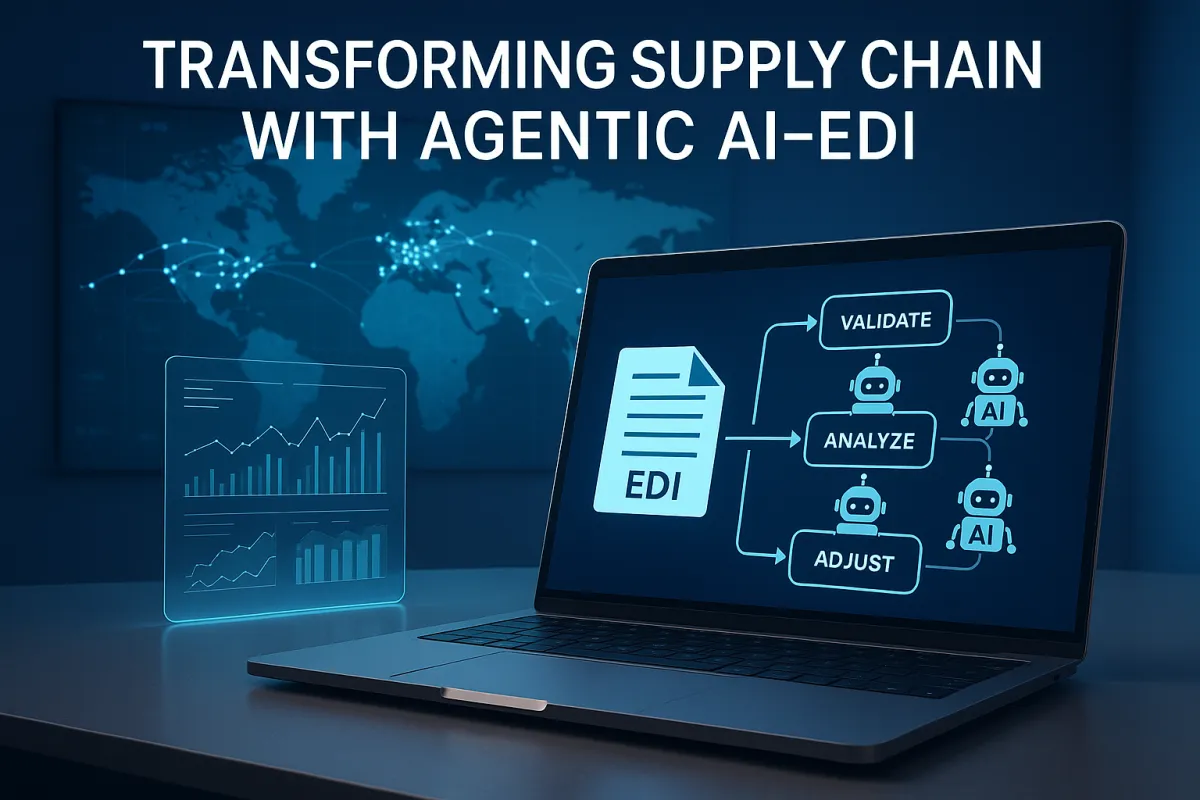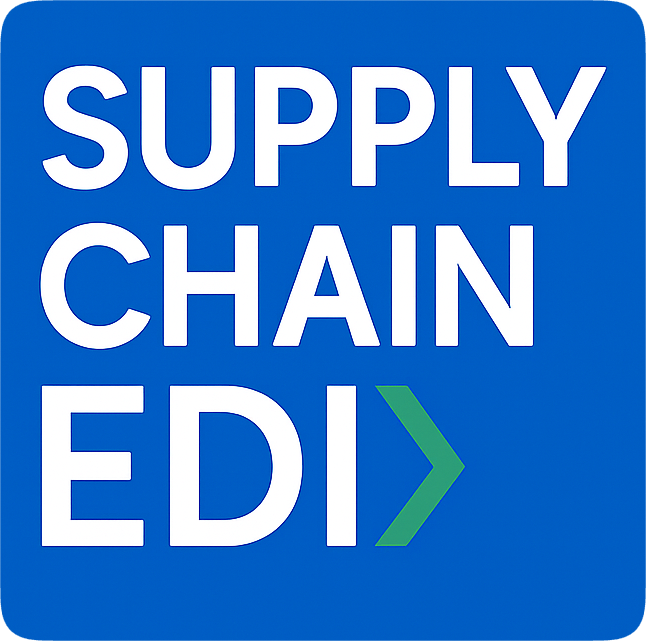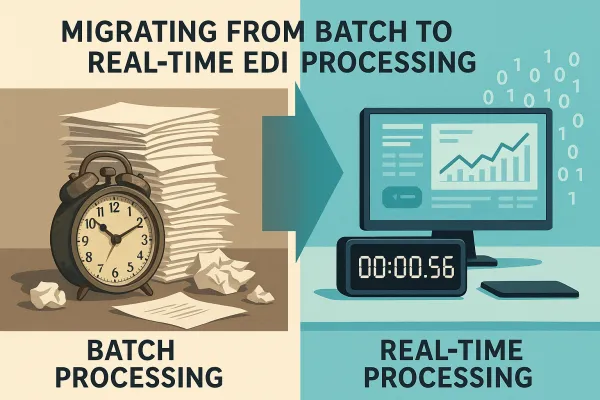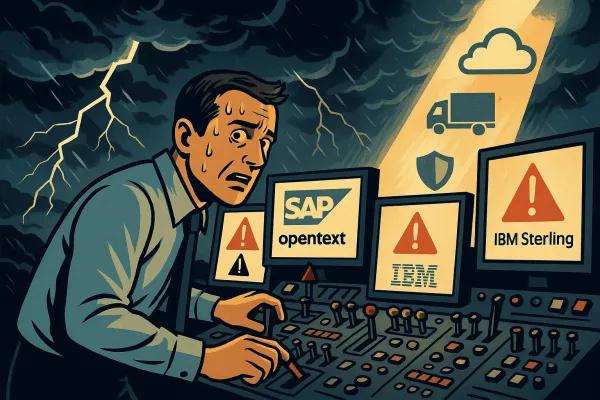The Agentic AI-EDI Implementation Roadmap: How to Transform Your Supply Chain from Rule-Based Automation to Autonomous Intelligence in 2025

Most supply chain leaders know their current EDI systems work—sort of. They exchange documents, move data, and keep trading partners connected. But what they're really managing is a reactive patchwork of rules and exceptions, not an intelligent system that adapts to real-time disruptions or learns from patterns to prevent future issues.
Agentic AI has entered the vocabulary of nearly every CIO around the world in 2025, with many companies still in the exploratory stages, creating a perfect opportunity for supply chain professionals to transform their approach to data exchange. This isn't about replacing EDI entirely—it's about evolving from automated document transmission to autonomous AI agents into EDI systems, enabling them to not only exchange structured data but also interpret, act on, and optimize that data in real time.
Understanding the Agentic AI Revolution in EDI Systems
Traditional EDI systems—while foundational—are increasingly seen as rigid, rule-based, and reactive. Enter agentic EDI: a transformative fusion of Agentic AI and EDI that goes far beyond the generative AI tools most organizations are experimenting with today.
Here's the fundamental difference: your current EDI setup processes an 850 purchase order, validates it against preset rules, and either passes it through or flags exceptions for human review. An agentic AI-enhanced system receives that same 850, analyzes it against real-time inventory levels, supplier performance data, and market conditions, then autonomously adjusts delivery schedules, suggests alternative suppliers for at-risk items, or even renegotiates terms based on current demand patterns.
By 2030, 50% of cross-functional supply chain management solutions will use intelligent agents to autonomously execute decisions in the ecosystem, according to Gartner. The difference between early adopters and those who wait? Companies with mature AI supply chain systems are achieving 25–30% higher operational efficiency than their peers in 2025.
Agentic AI is the next evolution of artificial intelligence, designed to act with purpose and make context-aware decisions. Unlike traditional AI, which relies on fixed datasets and rigid rules, Agentic AI uses goal-driven agents that continuously learn and adapt.
The Business Case for Autonomous EDI Implementation
The numbers tell a compelling story. The global AI in supply chain market hit $19.8 billion in 2025, up from $6.5 billion in 2022, a staggering 45.3% CAGR. But raw market growth means nothing without measurable returns for your specific operations.
Early adopters of AI in the supply chain industry improve logistics costs by 15%, inventory levels by 35%, and service levels by 65%. More specifically for EDI operations, organizations implementing agentic AI see dramatic improvements in partner onboarding times, error resolution, and exception handling.
Consider the hidden costs you're already absorbing: every manual intervention to resolve EDI mapping conflicts, every delayed shipment due to communication gaps between trading partners, every stockout because your system couldn't proactively adjust to supplier disruptions. 76% of CSCOs say their overall process efficiency will be improved by AI agents that perform repetitive, impact-based tasks at a faster pace than people can.
Organizations with higher AI investment in supply chain operations report revenue growth 61% greater than their peers. The competitive advantage isn't just operational—it's strategic. While competitors struggle with manual EDI troubleshooting, you're automatically rerouting shipments around port delays and adjusting purchase orders based on real-time demand signals.
Companies implementing agentic AI in supply chain optimization typically see ROI within 12-18 months, with the most significant gains in inventory turnover and delivery performance. The key is focusing on high-impact use cases rather than trying to transform everything simultaneously.
Pre-Implementation Assessment and Readiness Framework
Before diving into agentic AI, you need an honest assessment of your current EDI infrastructure. Most implementations fail because organizations underestimate the data quality requirements and overestimate their system integration readiness.
AI agents are only as good as the data they consume. Clean, structured, and real-time data is essential. Start with a comprehensive audit of your EDI transaction quality. What percentage of your 850s require manual intervention? How often do 856 advance ship notices contain incomplete or conflicting information? These aren't just operational hiccups—they're training data problems that will plague your AI agents.
Your technology stack compatibility analysis should focus on integration points, not just EDI standards. Agentic EDI must seamlessly connect with ERP, TMS, WMS, and supplier systems. The challenge isn't technical compatibility—it's data flow orchestration across multiple systems that weren't designed to share real-time information.
Skills gap assessment becomes particularly important because teams should be trained to work alongside autonomous systems and trust their outputs. Your EDI specialists won't become obsolete, but their role shifts from reactive problem-solving to strategic oversight and exception management.
Phase 1 - Foundation Building (Months 1-2)
Data standardization takes priority over everything else. Your agentic AI agents will only be as intelligent as the data patterns they can recognize and act upon. This means standardizing not just EDI message formats, but the business logic embedded within them.
Focus on your highest-volume trading partners first. The standardized and structured nature of EDI formats and EDI data exchanges means less data cleaning is likely required before feeding it into AI models. AI can also more easily extract patterns and insights from EDI across different trading partners and business networks.
Integration layer preparation involves more than API connectivity. You're building the data infrastructure that will enable your AI agents to access real-time information from multiple sources simultaneously. This includes connecting to external data feeds for weather, traffic, market conditions, and supplier risk assessments.
Vendor selection requires careful evaluation of both established EDI providers and emerging agentic AI platforms. Major players like IBM Sterling, SPS Commerce, and TrueCommerce are adding AI capabilities, while specialized providers like Cargoson, MercuryGate, Descartes, Manhattan Active, and Blue Yonder are developing native agentic AI features for their platforms.
Phase 2 - Pilot Implementation (Months 3-4)
Your pilot phase focuses on proving value with a limited set of trading partners and transaction types. Start with high-volume, standardized transactions where AI can demonstrate clear improvements in processing speed and accuracy.
The first insights phase involves deploying AI agents that can analyze structured EDI data alongside unstructured information like emails, PDFs, and spreadsheets from suppliers. AI agents extract the same shipping details from a supplier's emailed shipping notice or in alignment with the PO released, whether in PDF, spreadsheets, or other formats, to create inbound shipment records in the ERP or TMS. The business information is captured without enforcing strict EDI formats - all in real-time.
Performance monitoring becomes automatic rather than reactive. Your AI agents continuously track EDI transaction success rates, processing times, and exception patterns, providing insights that would take human analysts weeks to compile. Risk mitigation strategies include maintaining parallel traditional EDI processing for critical transactions until agent performance reaches acceptable reliability thresholds.
Rollback procedures are essential but often overlooked. Your AI agents need clear boundaries for when to escalate decisions to human oversight. This includes defining risk tolerance levels for autonomous purchase order modifications, supplier substitutions, and delivery rescheduling.
Phase 3 - Scaled Deployment (Months 5-6)
The parallel insights phase expands AI agent capabilities across multiple supply chain functions simultaneously. Your agents begin coordinating activities across procurement, inventory management, logistics, and supplier relationship management, making autonomous decisions that optimize the entire value chain.
A Procurement Agent raises purchase orders, while a Compliance Agent validates vendors and documents. The Transport Agent books freight and predicts ETAs, as the Warehouse Agent prepares slots and updates inventory. Simultaneously, the Production Agent aligns materials with demand, and the Customer Agent manages updates, returns, and visibility. Rather than operating in silos, these integrated agents collaborate instantly, creating a self-adjusting ecosystem.
Full trading partner network integration requires careful change management. Partners need visibility into how your agentic AI agents will interact with their systems, what autonomous decisions the agents can make, and how exceptions will be handled. Some trading partners may resist initial AI-driven interactions, requiring gradual introduction of agent capabilities.
Advanced features like sustainability tracking, contract lifecycle management, and returns automation become possible once your foundation is solid. Multi-Tier Visibility: Agentic EDI will extend beyond Tier 1 suppliers to monitor Tier 2 and Tier 3 risks and performance, providing unprecedented supply chain visibility.
Critical Implementation Challenges and Solutions
The biggest implementation challenge isn't technical—it's organizational. Teams should be trained to work alongside autonomous systems and trust their outputs. Your EDI specialists, who've built expertise in manually troubleshooting data mapping issues and resolving trading partner conflicts, need to evolve into AI orchestrators who design agent behaviors and manage exceptions.
Technical integration complexities with legacy systems often surprise organizations. Your ERP system might support EDI transactions perfectly, but struggle to provide the real-time data feeds that AI agents need for contextual decision-making. This requires infrastructure investments beyond basic EDI connectivity.
Vendor lock-in concerns become particularly relevant with agentic AI because the intelligence is embedded in the platform, not just the data processing. Guardrails must be in place to ensure AI agents operate within ethical, legal, and strategic boundaries. This includes maintaining data portability and ensuring your agents' learned behaviors can transfer to alternative platforms if needed.
Compliance and regulatory considerations multiply when AI agents make autonomous decisions that impact contractual obligations, financial commitments, and supply chain accountability. Your agents need clear decision-making boundaries that align with corporate governance requirements and trading partner agreements.
Common failure patterns include over-automating too quickly, insufficient testing with actual trading partner data, and inadequate change management for both internal teams and external partners. The organizations that succeed take a measured approach, proving value incrementally while building organizational confidence in agent capabilities.
Measuring Success and Continuous Optimization
Traditional EDI metrics like transaction volume and processing time become insufficient for measuring agentic AI performance. You need KPIs that capture the intelligent decision-making capabilities your agents provide.
Focus on process efficiency improvements that directly impact business outcomes. 87% of enterprises use AI for demand forecasting, driving a 35%+ improvement in accuracy, while 67% report a 28% drop in stockouts through AI-based inventory management. For EDI specifically, measure how often your agents proactively resolve issues before they impact operations.
Partner onboarding time reduction provides a clear ROI metric. Traditional EDI onboarding can take 3-6 months per trading partner, involving extensive mapping, testing, and validation cycles. Organizations can receive shipment notifications from any supplier regardless of their technical capabilities, eliminating the need for costly EDI integrations while maintaining complete visibility into inbound logistics.
Error rate and exception handling improvements should show steady progress as your agents learn from patterns and adapt their behaviors. Track both the reduction in EDI transaction errors and the speed of exception resolution when issues do occur.
Long-term evolution planning requires continuous assessment of agent capabilities and business needs. The future should be AI-orchestrated—with AI agents learning, adapting, and running enterprise processes in real time. Your roadmap should anticipate expanding agent responsibilities as organizational confidence and technical capabilities mature.
The transition from rule-based EDI automation to autonomous intelligence isn't just a technology upgrade—it's a fundamental shift in how your supply chain operates. Organizations that successfully navigate this transformation will gain sustainable competitive advantages through superior agility, reduced operational costs, and enhanced trading partner relationships. The question isn't whether agentic AI will transform EDI systems, but whether your organization will lead or follow this evolution.





